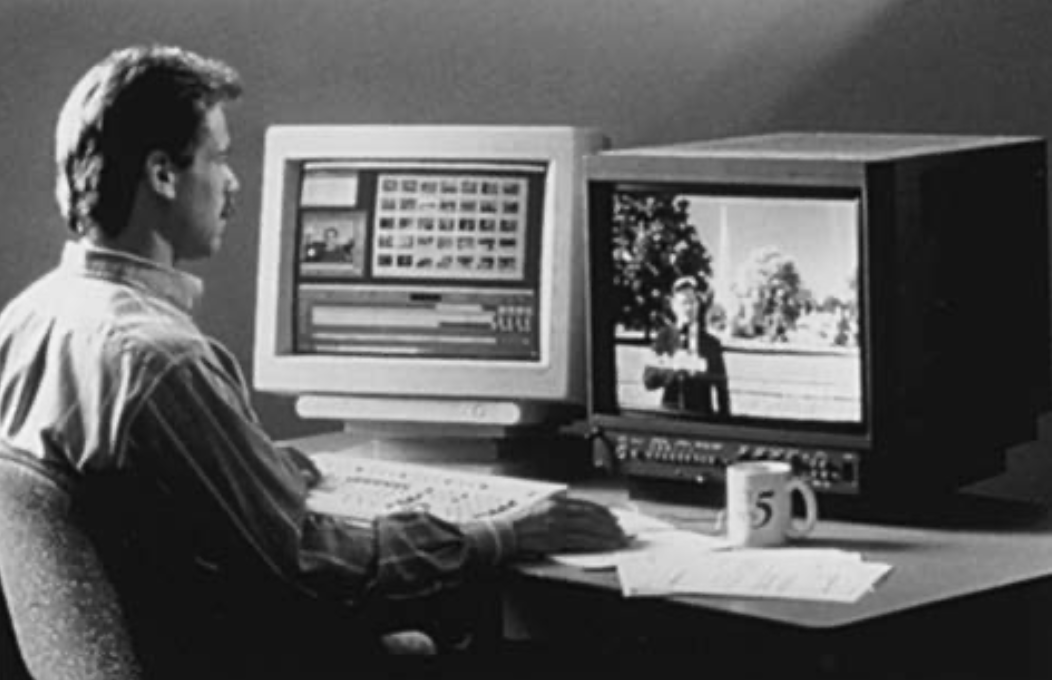Computers in Television
Computers in Television
The advent of computers has had a tremendous effect on the television and the video industry. Smaller, faster personal computers and computer chips have reduced camera sizes, revolutionized editing, and brought the process of video production to the desktop.
An example of computers used in television production.
Photo courtesy of Avid Technology, Inc.
Bio
Cameras have benefited from the increased computer power and decreased chip size. Computer chips, called charged coupled devices (CCDs), have replaced tubes as image-processing devices in video cameras. Because CCDs are small and provide good resolution, high-quality cameras have become smaller, more portable, and better able to provide good pictures in low-light situations. Other types of computer chips are also used to control some studio cameras. These cameras have an internal memory that automatically retains the correct camera settings, ensuring accurate synchronization between camera and the camera control unit and allowing easy registration and alignment. Other cameras even have remote control capabilities that allow the camera operator to preload shots during rehearsal and then recall them at the appropriate moment with the touch of a button.
Computers have also enhanced other production equipment. Still-stores and frame stores, devices that capture one frame of video and store it in memory for future use, rely on computers. Still-stores and frame stores are often used to generate the graphics that accompany news anchors as they introduce news stories. Digital video effects, such as rotating images, morphing (when one image turns into another), and image stretching, previously sent out to specialty shops, can now be done on the premises, for less money, with a computer.
Computer-generated imaging is also on the rise and is used widely in a variety of applications such as computer graphics, titles, paint systems, and three-dimensional animation. Technology enables computer-generated images often to look “real” or to be so well integrated in postproduction that they appear to be a part of the camera-generated images. This area is likely to continue to increase in sophistication.
Computerization has also allowed more automation. At NBC network studios, satellite feeds to affiliates and master control of programming are largely in the hands of a computer. Some local television stations also use computers to keep track of their air traffic and master control.
Perhaps the biggest change in the television production process has come in postproduction. The change began when computers were found to be useful in controlling videotape recorders using timecode. By adding a character generator and a switcher and using a computer-generated edit decision list, a new online editing process was born. Timecode and the computer provided an accuracy not achieved before.
Nonlinear editing has progressed beyond computer-controlled videotape recorders. Nonlinear editing is performed with a personal computer outfitted with hardware and software that enable it to digitize the video and audio and store them on computer disk. Nonlinear editing is often referred to as “random access editing” because it provides the editor with random access to the source material stored on a computer disk. Therefore, it is not necessary to wait for the source tape to fast-forward or rewind to a desired scene. One of the biggest advantages of nonlinear editing is that if the timing of an edit is unacceptable, it can be changed easily. Unlike linear editing, segments can be tightened or extended without revising subsequent edit points. Segments can also be effortlessly added, deleted, and moved around within the program. At present, nonlinear editing is most often used for offline editing because a high-quality digital-to-analog converter is needed to convert the finished product to a broadcast-quality product. Generally, an edit decision list is generated and online editing is done in a computer-controlled editing suite. However, companies such as Avid are developing high-quality online nonlinear editing systems.
In general, the introduction of computers to the television and video industry has demystified the industry and made it possible for individuals to produce video at a relatively affordable price. “Desktop video” has become a viable production process especially for independent and corporate producers. Small, portable, high-quality cameras and desktop editing systems can cost as little as $10,000 total. Macintosh-based systems such as Adobe Premiere and Avid Media Suite Pro provide special effects, transitions, filters, and a means for digitizing video. Similar systems exist for other platforms. Of particular note is the Video Toaster, which is on Commodore’s Amiga platform and was specifically designed to interface with video systems. This system is capable of performing many functions of traditional video production and does not have the problems with conversion to analog that other systems have. However, because the Commodore is not a popular platform, the market for the Toaster is not very large and its future is unclear. What is clear is that the future of desktop video is bright. Television and video are no longer confined to the broadcast industry. Video on the computer, in educational settings, games, and other applications, will become even more commonplace. As interactive television and the information superhighway continue to develop, television, television equipment, and television production will continue to change.

